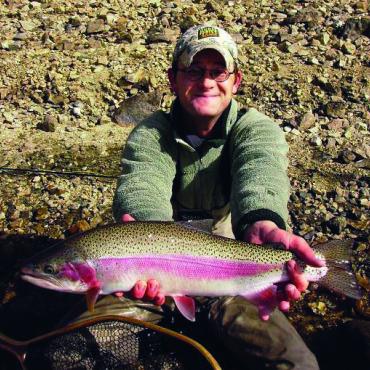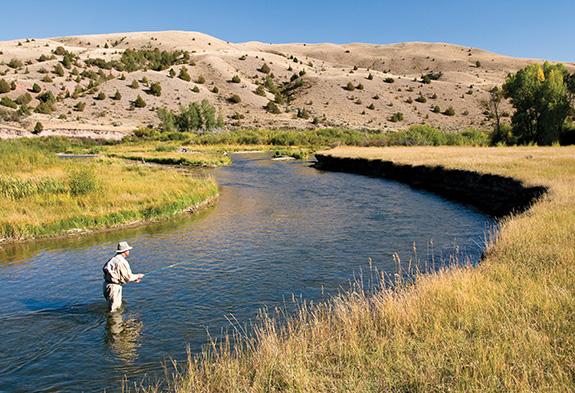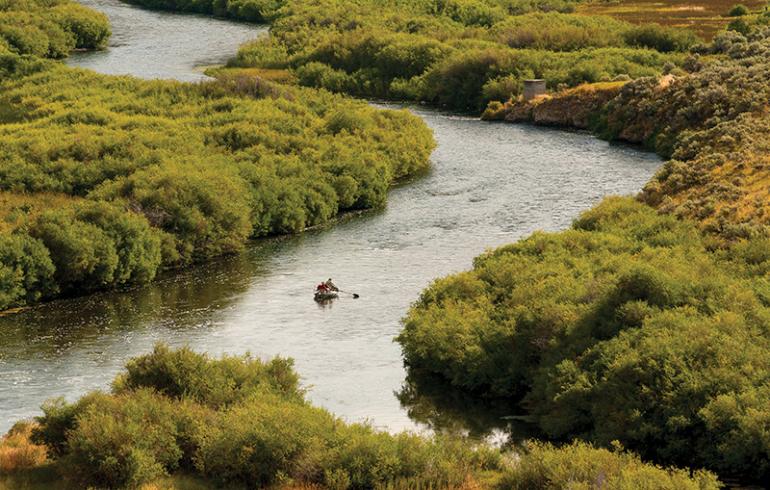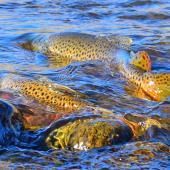Beaverhead: Small & Mighty
An off-the-beaten-path trout stream.
The Beaverhead is one of the more endearing rivers in southwest Montana, owing to its fish-producing prowess and unassuming appearance. From afar, this river looks more like a blown-up meadow creek than a trout factory, twisted and meandering this way and that. Mild flows and a bed whose composition ranges from sand to pea-gravel allow for abundant aquatic vegetation. This vegetation is an ideal habitat for the insects which provide a reliable food source for fish. The Beaverhead flows from Clark Canyon Reservoir approximately 69 miles to its confluence with the Big Hole and Ruby rivers to form the headwaters of the Jefferson.
Access
The section from Clark Canyon Dam downstream to Barretts Diversion is easily accessed via six public sites. Both wading and floating anglers will find this upper portion of the river productive. Heading downstream from Barretts, the official access points grow increasingly scarce. While fantastic fishing can be had from Dillion to Twin Bridges, be prepared for very long days on the water: only five access sites exist, and they’re several river-miles apart.
Flows
On average, flows on the Beaverhead range from 500cfs to 1,000cfs. Releases of water from the reservoir are controlled by the Bureau of Reclamation, dictated by irrigation demand downstream. If you’re planning a trip on the Beav, pay close attention to snowpack, runoff, and potential drought conditions. If water looks to be scarce, plan your fishing trip for earlier in the season.
When to Go
The Beaverhead is a veritable bug bonanza, and given the proper conditions, prolific hatches occur almost every month of the year. During the early to mid-spring months, overlapping hatches of baetis, caddis, and midges are common. Clouds of insects continue to thicken into the summer months with little yellow sallies, PMDs, spruce moths, tricos, and various terrestrials. With the abundance of hatching insects, you’d think this river would be a topwater cakewalk all day long, but the best dry-fly fishing usually happens at dusk and dawn. Nymphs and subsurface patterns tend to be more productive during the day. Scuds, larva, aquatic worms, and leaches are also abundant on the Beaverhead, and an imitation of one of these invertebrates paired with a small soft-hackle or mayfly nymph is a good setup. Like other rivers in Montana, prime streamer-fishing season on the Beav usually occurs during the early spring, and ramps up again during mid-autumn.
Fish
The Beaverhead is known to produce some of the burliest brown trout in Montana, and on a good day, it’s possible to net at least one 20-incher. Considerable numbers of chubby, football-shaped rainbows also cruise this river. While overall fish numbers increase the closer one gets to the dam’s spillway, in the lower stretches, fish size increases as population density decreases. The Beaverhead is a very popular river, with an abundance of food options and angling pressure, so don’t be surprised if your tried-and-true patterns get snubbed.
Row vs. Wade
The upper section of the Beaverhead, from the dam to Barretts Diversion, is the most accessible and productive for wading anglers. Access sites are clearly marked, and the flows are generally such that wading is relatively easy. For those lucky folk with access to a boat or raft, this river offers miles of fish-filled water. Floaters should be prepared for hairpin bends and gnarly sections of overhanging brush. Pop into a local fly shop in Twin Bridges or Dillon to get the skinny on floating or wading conditions throughout the year.
Regs
As always, consult the current FWP regs before hitting the water. Grab a booklet at your local license provider or look them up online at fwp.mt.gov. Depending on flows, the Beaverhead may be subject to seasonal closures or hoot-owl restrictions (fishing closures after 2pm through midnight due to high water temperatures).
Getting There
Heading west on I-90 from Bozeman, take the Whitehall exit, then continue on to Hwy 55/41 south, through the town of Twin Bridges and on to Dillon.
Kurt Dehmer owns Durty Kurty's Guide Service in Bozeman.













